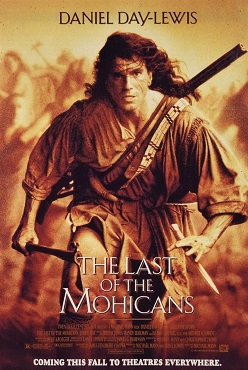SYNOPSIS: A
modern interpretation of the James Fenimore Cooper classic. Hawkeye (Daniel
Day-Lewis) and his two Mohican pals attempt to protect two English lasses from
the villainous Magua (Wes Studi). Throw in the siege of Fort William Henry
during the French and Indian War.
BACKSTORY: “The Last of the Mohicans” was released in 1992. It was the first big budget feature from director Michael Mann. It was very loosely based on the John Fennimore Cooper novel, but actually is closer to the 1936 Randolph Scott film. The movie is set in 1757, three years into the French and Indian War. Although the action takes place in upstate New York, it was actually filmed mostly in North Carolina. The production used 1,000 Native American actors and extras. Mann had a 20 acre frontier farm, a Huron village, and a replica of a British fort built. The director’s obsessive quest for authenticity was matched by his star Daniel Day-Lewis who completely immersed himself in his role. Part of his preparation involved a “colonial boot camp” experience in the backwoods. Mann used a respected authority named Mark Baker to vet the film. Baker is an expert on frontier life, Indians, and weaponry. Mann provided him with a copy of the script and in most cases made changes suggested by Baker. The movie was a box office success and critically acclaimed. It was awarded an Oscar for Sound.
TRIVIA: wikipedia, imdb, TCM
BACKSTORY: “The Last of the Mohicans” was released in 1992. It was the first big budget feature from director Michael Mann. It was very loosely based on the John Fennimore Cooper novel, but actually is closer to the 1936 Randolph Scott film. The movie is set in 1757, three years into the French and Indian War. Although the action takes place in upstate New York, it was actually filmed mostly in North Carolina. The production used 1,000 Native American actors and extras. Mann had a 20 acre frontier farm, a Huron village, and a replica of a British fort built. The director’s obsessive quest for authenticity was matched by his star Daniel Day-Lewis who completely immersed himself in his role. Part of his preparation involved a “colonial boot camp” experience in the backwoods. Mann used a respected authority named Mark Baker to vet the film. Baker is an expert on frontier life, Indians, and weaponry. Mann provided him with a copy of the script and in most cases made changes suggested by Baker. The movie was a box office success and critically acclaimed. It was awarded an Oscar for Sound.
TRIVIA: wikipedia, imdb, TCM
1. It
relies more on the 1936 version than the book.
Thank God!
2. The
Blue Ridge Mountains in North Carolina stood in for the Adirondacks.
3. Daniel
Day-Lewis lived in the wilderness for several weeks to prepare for his
role. He got into the role so much that
after the shoot he suffered from claustrophobia and mild hallucinations.
4. Randy
Edelman finished the score because Trevor Jones had another commitment and
there may have been some artistic differences between Jones and director Michael
Mann.
5. Recreation
of Fort William Henry cost $6 million.
6. The
film used hundreds of Native American extras, mostly Iroquois.
7. Russell
Means was making his film debut. He was
famous for being a leader of the American Indian Movement and participated in
the Wounded Knee occupation.
Belle and Blade = N/A
Brassey’s =
3.0
Video Hound =
3.8
War Movies =
N/A
Military History = #95
Channel 4 =
#35
Film Site = yes
101 War Movies = yes
Rotten Tomatoes = no
OPINION: This is a magnificent movie. It combines an interesting plot with great acting and a real concern for historical accuracy. Kudos to Michael Mann for getting the little details right. Let’s face it, even war movie nuts do not care if the moccasins are circa 1757. However, when a director insists on accuracy down to the ground and cares if anyone will notice, you get a better movie for purists. Also commendatory was the tampering with the plot of the novel. I admit I get upset when a nonfiction source is changed to Hollywoodize a movie, but I do not think it is hypocritical to endorse what Mann and the screenwriters have done. Especially since most literary critics are not big fans of the novel. As long as you get the historical facts mostly right, why not make the tale better? The movie also looks good. The scenery is breathtaking. Parts of North Carolina really do look like the frontier of colonial America. The score is perfect. So here we have a movie with great acting, a moving score, realistic sound, romance, action, suspense, violence, and historical accuracy. I would rank it higher, but I think #43 is fair.

I agree that the attention to detail is a real plus to this movie. The characters also thread the needle of feeling for the most part to live in the period, rather than seeming like time-travelling tourists from modern times or, on the other hand, like historical reenactors showing off the customs and styles of the olden days. It's an achievement that becomes more impressive the more one sees movies that fail to find this happy middle ground.
ReplyDeleteAgree.
DeleteCooper's books are (judged by modern standards) over-written, and reading them is like wading through a swamp, even though the stories have as much action as Ian Fleming, Mickey Spillane, or Louis L'Amour. For that reason, they actually work better in a visual medium, where you don't have to slog through the tedious narration.
ReplyDeleteI see where you are going there, but The Last of the Mohicans has some truly silly scenes.
Delete